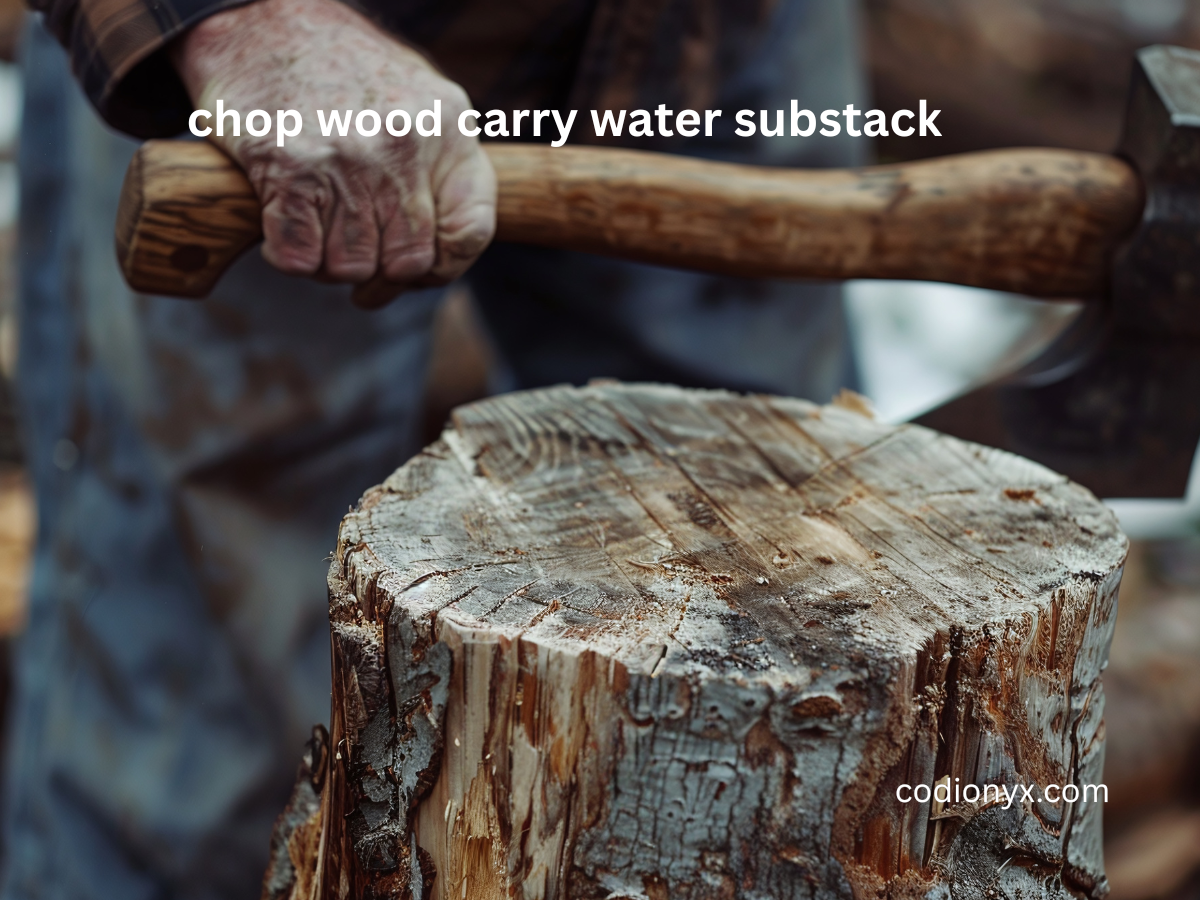Introduction
A silent but potent movement that combines traditional philosophy with contemporary mindfulness is emerging in an era where digital noise vies for our attention and productivity tricks guarantee instant success. The core of this is a Zen Buddhist saying: “Chop wood, carry water.”
The Chop Wood Carry Water Substack is a developing newsletter that is a current manifestation of its idea. This Substack, which has an expanding readership, speaks to a profound need for presence, discipline, and clarity in our chaotic environment. However, what is it? Who is the author? And why is it so popular as a source of advice?
Let’s examine the Chop Wood Carry Water Substack’s main ideas, target audience, important takeaways, and the meaning behind the name.
The “Chop Wood Carry Water” Substack: What Is It
A Substack newsletter, Chop Wood Carry Water draws inspiration from timeless spiritual teachings and useful life skills. Typical subjects covered include: • Mindfulness and present; • Habit formation and daily discipline; • Mental health and emotional resilience; • Simplicity in an overly connected world; and • The meeting point of traditional wisdom and contemporary living.
The Zen saying, “Before enlightenment, chop wood, carry water,” is the inspiration behind the newsletter’s name. After enlightenment, carry water and cut wood.
The message? Living life to the fullest is what enlightenment is all about, not running away from it. This entails accepting the everyday grind with humility, presence, and purpose.
With weekly or biweekly observations, essays, and prompts to slow down, simplify, and realign, The Substack brings this wisdom into the present era.
Chop Wood Carry Water on Substack: Who Writes It?
Although the phrase “Chop Wood Carry Water” has been used by a number of authors and newsletters, Joshua Medcalf, author of the well-known book Chop Wood Carry Water: How to Fall in Love with the Process of Becoming Great, has compiled one of the most prominent and frequently read versions. Nonetheless, a number of authors on Substack reaffirm this concept through coaching, philosophical analysis, and personal narratives.
No matter who writes the edition, the voice is usually: • Introspective • Grounded • Motivating • Intellectually honest • Process-oriented rather than outcome-focused
The platform is used by writers who have expertise in coaching, philosophy, mental health, or creative fields to impart practical insights rather than glitzy tricks.
Reasons for the Name
Originating in ancient Zen teachings, the saying “Chop wood, carry water” has evolved into a contemporary metaphor for the importance of perseverance, modesty, and conquering the ordinary.
Essential Meanings:
• Mindfulness in the Present: A spiritual awakening only alters your perspective on life’s tasks; it does not absolve you of them.
• Discipline > Motivation: Repetition, not epiphanies, is the key to mastery.
• Ego-Free Action: Quietly carrying out necessary tasks is the path to true peace, not grandiose gestures.
• Daily Enlightenment: Sometimes the task itself is the purpose; you don’t always need to escape your everyday responsibilities to discover it.
This idea serves as the foundation for The Substack’s reflections on contemporary issues, such as burnout, overstimulation, creative block, self-doubt, and the desire for a more leisurely, introspective existence.
Typical Subjects and Themes
Chop Wood Carry Water Substack postings frequently touch on the following subjects:
1. Slow Production
It encourages concentrated, meaningful effort over time rather than rushing for hustle all the time.
2. Routine’s Power
Journaling, walking, cooking, and meditation are examples of everyday routines that are presented as sacred practices that foster inner fortitude.
3. Letting Go of Ego Authors tell tales of vulnerability, failure, and surrender—not to give up, but to develop.
4. Minimalism in Spirituality
Reduce consumption and increase presence. More consciousness, less noise.
5. Questions for Reflection
The following questions are frequently posed to readers: • “What do you want that you already have?”
• “Where can you be more present in your life?”
• “Is there a task you’ve been putting off that might turn into a ritual?”
6. Process-Based Growth
Not everything needs to be optimised or flawless. Continue cutting. Continue to carry.
Reasons for Subscribing
What is the reason behind the rise in popularity of the Chop Wood Carry Water Substack?
• It’s not too much: No “ultimate life hacks” or 20-step productivity manuals.
• It seems intimate: A lot of entries resemble letters from sage friends.
• It fits in with the culture of burnout today: The hustling culture has worn people out. This provides a stronger yet softer substitute.
• It imparts useful knowledge: Not metaphysical or abstract, but grounded, practical, and actionable.
It fosters community: Common human experiences are frequently reflected in the comment sections.
Chop Wood Carry Water Sample Quotes
The tone and lessons are encapsulated in these quotations from the chop wood carry water substack and related works:
“The prize isn’t out there somewhere. Now it’s the sound of wood being split by an axe.
“Avoid pursuing clarity. Arrive for the day. Allow clarity to guide your efforts.
“You don’t require additional inspiration. You need more opportunities to show up when you don’t want to.
No application can increase your presence. However, this particular moment is awaiting your whole attention.
Joshua Medcalf’s Chop Wood Carry Water is a related book.
Although it is not included in the chop wood carry water substack, the tone and message of Joshua Medcalf’s book chop wood carry water substack are very similar. It narrates the tale of a youngster undergoing samurai training and the lessons he gains from performing seemingly routine things. It is frequently mentioned as basic reading in the Substack community.
One of the book’s main takeaways is to prioritise the process over the outcome.
2. Real growth comes from within.
3. Discipline instead of inspiration.
4. Appreciate the effort as much as the result.
Conclusion
The Chop Wood Carry Water Substack is more than simply a periodical; it’s a way of life, a philosophy, and a subtle shift in the way we view contemporary living.
This chop wood carry water substack encourages us to move more slowly, deeply, and purposefully in a world that is fixated on moving bigger, louder, and faster. It serves as a reminder that the little things, like brewing coffee, walking the dog, or writing a sentence at a time, may often result in the biggest changes.
We don’t leave the world; rather, we grow more alive in it when we embrace life’s everyday routines with purpose and attention.
Therefore, subscribe to chop wood carry water substack if you’re feeling burned out, overstimulated, or just interested in living a deeper life. Not to be motivated, but to keep in mind what’s important.
FAQs
Q1: Is the Water Substack with chop wood carry water substack Carry Free?
Yes, the majority of versions provide free posts; but, for access to the community or more in-depth information, paid subscriptions are optional.
Q2: Is this newsletter spiritual or religious in nature?
Not in a conventional way. Although it incorporates elements of Eastern and Zen philosophy, its focus is more on attitude and way of living than doctrine.
Q3: How frequently do posts get published?
Depending on the author, the majority ofchop wood carry water substack newsletters publish either weekly or biweekly.
Q4: Is it possible for me to write my own version or contribute?
Of course. This theme is used by many chop wood carry water substack writers to generate their own reflections. You can begin your own if the message speaks to you.
Q5: Is it exclusively for those with a spiritual interest?
Absolutely not. Creatives, sportsmen, businesspeople, therapists, educators, and everyone else looking for serenity by presence and constancy are among the readers.









